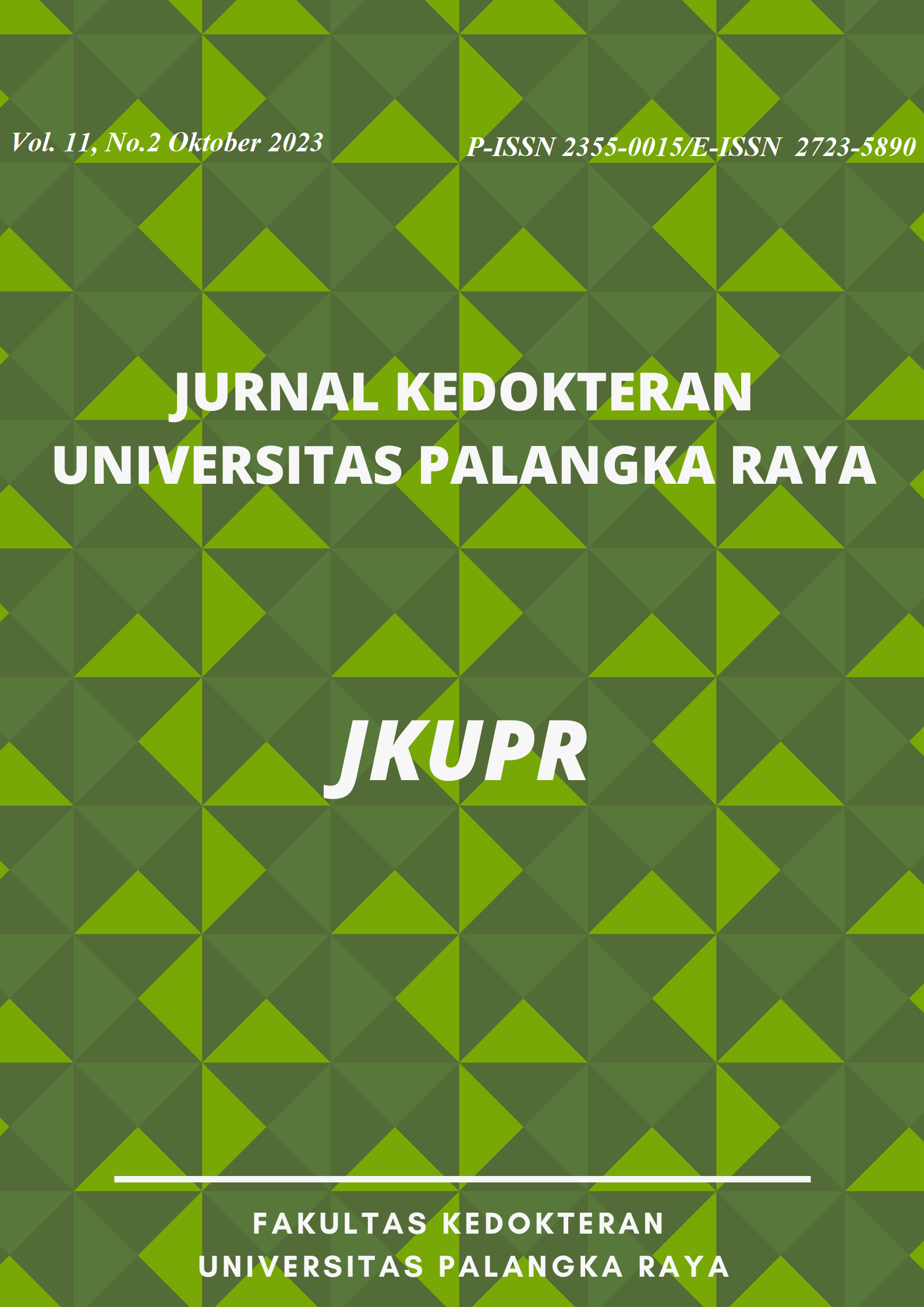Identifikasi larva nyamuk di Desa Lawang Uru Kabupaten Pulang Pisau
DOI:
https://doi.org/10.37304/jkupr.v11i2.11039Keywords:
identifikasi larva nyamuk, spesies larva nyamuk, tempat perindukan nyamukAbstract
. In tropical nations like Indonesia, mosquitoes serve as carriers of viruses and parasites that can infect humans. Finding out which mosquito larvae species were present and where in Banama Tingang District—particularly in Lawang Uru Village—was the study's main goal. Descriptive survey research using simple random sampling methodology is what this study is. All of the mosquito larvae used in this study were collected from Lawang Uru Village. In residential areas, larvae are collected. Descriptive survey research using simple random sampling methodology is what this study is. All of the mosquito larvae used in this study were collected from Lawang Uru Village. In residential areas, larvae are collected. The study's findings revealed 232 larvae belonging to the following species: Culex quinquefasciatus, Aedes albopictus, Culex vishnui, and Aedes aegypti. utilized paint cans, tires, drums, boats, and livestock feeders were among the materials utilized to create larval breeding habitat in Lawang Uru Village.
Downloads
References
World Health Organization, 2015. Malaria.
http://www.who.int/mediacentre/factsheets/fs094/en/
Riset Kesehatan Dasar, 2013. Malaria. Badan Penelitian dan Pengembangan Kesehatan Kementerian Kesehatan Republik Indonesia.
Kementerian Kesehatan Republik Indonesia, 2018. Infodatin Menuju Indonesia Bebas Filariasis.
Gafur A, Jastam MS, 2015. Faktor yang berhubungan dengan keberadaan jentik nyamuk Aedes aegypti di Kelurahan Batua Kota Makassar. Al-Sihah : Public Health Science Journal 7(1) : 50 – 62.
Munif A, 2009. Nyamuk Vektor Malaria dan Hubungannya dengan Aktivitas Kehidupan Manusia di Indonesia. Aspirator, 2(1) : 94 – 102.
Sembel DT, 2009. Entomologi Kedokteran. Yogyakarta : Penerbit Andi.
Dale P, Sipe N, Anto S, Hutajulu B, Ndoen E, Papayungan M, Saikhu A, Prabowa YT, 2005. Malaria in Indonesia : A Summary of Recent Research Into Its Environmental Relationships. Southeast Asian Journal Tropic Medice Public Health 36(1) : 1 – 13.
Widiyanti NPLM, Artawan IK, Dewi NPSR, 2016. Identifikasi Larva Nyamuk Yang Ditangkap Di Perindukan Di Kabupaten Buleleng : Prosiding Seminar Nasional FMIPA 2016, pp : 268-76.
Badan Pusat Statistik Pulang Pisau, 2016. Statistik Daerah Kecamatan Banama Tingang 2016.
Munif A, Imron TA, 2010. Panduan Pengamatan Nyamuk Vektor Malaria, Jakarta : CV.Sagung Seto.
Harbach RE, 2004. The classification of geneus Anopheles (Diptera:Culicidae): a working hypothesis of phylogenetic relationships, Bulletin of Entomological Research 94 : 537-53.
Nugroho SS, Mujiono, 2020. Pembaruan informasi taksonomi nyamuk dan kunci identifikasi fotografis genus nyamuk (Dipteri:Culicidae) di Indonesia.
Foley DH, Rueda LM, Wikerson RC, 2007. Insight into global mosquito biogeography from country spesies records. Journal of Medical Entomology 44(4) : 554 – 67.
Hadi UK, Soviana S, Gunandi DD, 2012. Aktivitas nokturnal vektor demam berdarah dengue di beberapa daerah di Indonesia. Jurnal Entomologi Indonesia 9(1) : 1 – 6.
Ramadhani T, Soeyoko, Sumarni S, 2010. Culex quinquifasciatus Sebagai Vektor Utama Filariasis Limfatik Yang Disebabkan Wuchereria bancrofti di Kelurahan Pabean Kota Pekalongan. Jurnal Ekologi Kesehatan 9(3) : 1303 – 10.
Departemen Kesehatan RI, 2007. Ekologi dan Aspek Perilaku Vektor. Direktorat Jenderal Pengendalian Penyakit dan Penyehatan Lingkungan.
Laihad FJ, Arbani PR, 2012. Malaria dari Molekuler ke Klinis : Situasi Malaria di Indonesia dan Penanggulangannya Edisi ke-2, Jakarta : Penerbit Buku Kedokteran EGC.
Dinas Kesehatan Provinsi Kalimantan Tengah, 2014. Spesies Anopheles di Kalimantan Tengah.
Service M, 2009. Medical Entomology for Students Fourth Edition. Cambridge University Press.
Richwanto F, Hestiningsih R, Saraswati LD, 2013. Hubungan Kejadian Keberadaan Tempat Perindukan Nyamuk Aedes aegypti Dengan Kejadian Demam Berdarah Dengue di Tiga Kelurahan Endemis Kota Palangka Raya Tahun 2012. Jurnal Kesehatan Masyarakat 2(2).
Sorontou Y, 2014. Ilmu Malaria Klinik, Jakarta : Penerbit Buku Kedokteran EGC.
Husin H, 2007. Analisis Faktor Resiko Kejadian Malaria di Puskesmas Sukamerindu Kecamatan Sungai Serut Kota Bengkulu Propinsi Bengkulu. Universitas Diponegoro, Semarang.
Imbiri JK, Suhartono, Nurjazuli, 2012. Analisis Faktor Risiko Malaria Di Wilayah Kerja Puskesmas Sarmi Kota, Kabupaten Sarmi, Tahun 2012. Jurnal Kesehatan Lingkungan Indonesia 11(2) : 130 -7.
Sanjana P, Barcus MJ, Bangs M, Ompusunggu S, Elyazar I, Harijani M, Tuti S, Sururi M, Tjokrosonto S, Baird JK, 2006. Survey Of Community Knowledge, Attitudes, and Practices During A Malaria Epidemic In Central Java, Indonesia. The American Society of Tropical Medicine and Hygiene 75(5) : 783–89.
Zainuddin M, 2011. Metodologi Penelitian Kefarmasian dan Kesehatan, Surabaya : Airlangga University Press.
Dahlan MS, 2011. Statistik untuk Kedokteran dan Kesehatan Edisi ke-5, Jakarta : Penerbit Salemba Medika.
Jabal, A. R., Akbar, H., Permana, G. I. ., Hanasia, Setyaji, F. A. D. ., Kurniawan, M. Y. I. ., Darmawan, M. R. ., & Ratnasari, A. (2023). Edukasi pengendalian nyamuk sebagai vektor penyakit kepada siswa SMAN 2 Palangka Raya. Panrita Abdi - Jurnal Pengabdian Pada Masyarakat, 7(3), 563-568. Doi: 10.20956/pa.v7i3.20789.
Tahir F, Bansal D, Rehman Au, Ajjur SB, Skariah S, Belhaouari SB, Al-Romaihi H, Al-Thani MHJ, Farag E, Sultan AA and Al-Ghamdi SG. 2023. Assessing the impact of climate conditions on the distribution of mosquito species in Qatar. Front. Public Health 10:970694. doi: 10.3389/fpubh.2022.970694.
Reinhold JM, Lazzari CR, Lahondère C. Effects of the Environmental Temperature on Aedes aegypti and Aedes albopictus Mosquitoes: A Review. Insects. 2018;9(4):158. Published 2018 Nov 6. doi:10.3390/insects9040158.
Ratnasari A. Jabal AR, Rahma N, Rahmi SN, Karmila M, Wahid I. 2020. The ecology of Aedes aegypti and Aedes albopictus larvae habitat in coastal areas of South Sulawesi, Indonesia. Biodiversitas 21(10):4648–4654. doi: 10.13057/biodiv/d211025.
Ratnasari A, Jabal AR, Syahribulan, Idris I, Rahma N, Rustam SNRN, et al. Salinity tolerance of larvae Aedes aegypti inland and coastal habitats in Pasangkayu, West Sulawesi, Indonesia. Biodiversitas J Biol Divers. 2021; 22(3): 1203–10. Doi: 10.13057/biodiv/d220316.
Higa Y. Dengue Vectors and their Spatial Distribution. Trop Med Health. 2011;39(4 Suppl):17-27. doi:10.2149/tmh.2011-S04.
Augustina I, Jabal AR, Permana GI, Ratnasari AR. 2020. Distribution and ecology of mosquito larvae in Pahandut Sub-District Palangka Raya City. J Phys: Conf Ser ICMSE 2020.
Skiff JJ, Yee DA. Behavioral differences among four co-occurring species of container mosquito larvae: effects of depth and resource environments. J Med Entomol. 2014;51(2):375-381. doi:10.1603/me13159.
Downloads
Published
How to Cite
Issue
Section
License
Copyright (c) 2023 Jurnal Kedokteran Universitas Palangka Raya

This work is licensed under a Creative Commons Attribution-NonCommercial-ShareAlike 4.0 International License.





















